 |

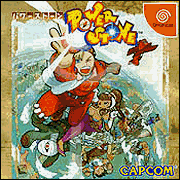
POWER STONE
T-1201M
Copyright © Capcom Japan
Sega Dreamcast
1-2 Players
VS Fighting
VMS Mini Games Included
¥6800
Available now in Japan
Where to buy
FAQ
—by Kenneth Lee

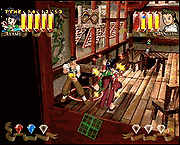
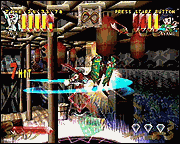


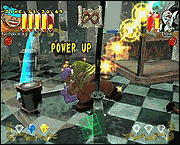
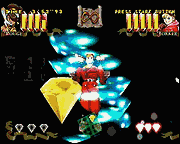

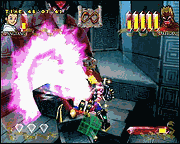
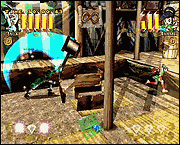
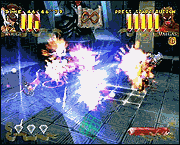
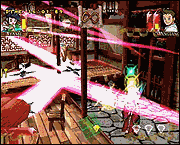

|
 |

Once the proverbial golden goose and darling of gamers everywhere, fighting
games have now become the most inundated and stagnant genre of them all.
Gone is the spark and frenzy that ignited the original fighting game
revolution many years ago (STREET FIGHTER II). While the hard-core
fighting fans will beg to differ, the majority of gamers out there greet
new fighting games with groans and the immediate response of "Ugh! Yet
another one." But upon closer inspection you'll realize that the fighting
genre hasn't really died, it's diversified. For combo-crazy people, there
was KILLER INSTINCT and the Capcom "Vs." games; for gore and violence,
there was MORTAL KOMBAT;
weapon-based fighting had SAMURAI SHODOWN and SOUL
CALIBUR; and for more skill-based action there were always the "true"
STREET FIGHTER and VIRTUA FIGHTER
series, TEKKEN, etc. Indeed most of the
original STREET FIGHTER crowd diversified and split off, and many stopped
playing altogether. No matter what incarnation, this was marginalizing the
genre and making it so that games were more and more for the hard-core
veterans only.
 Then Square attempted something new by introducing true 3D fighting games
(TOBAL 2,
BUSHIDO BLADE), allowing you to move just about anywhere; and
from there arena fighters were born. Now Capcom Japan has stepped up again
to bring yet another fighting game revolution with their Dreamcast release
of POWER STONE. What make POWER STONE so engaging are its stunning
graphics, simple controls, high polish, and truly interactive
environments—which open up a slew of new possibilities for gameplay.
And POWER STONE is doubly important in that it's not only a breath of fresh
air to the fighting game genre, but also shining proof that 100%+ Naomi
(arcade) to Dreamcast (home console) conversions are a reality. Then Square attempted something new by introducing true 3D fighting games
(TOBAL 2,
BUSHIDO BLADE), allowing you to move just about anywhere; and
from there arena fighters were born. Now Capcom Japan has stepped up again
to bring yet another fighting game revolution with their Dreamcast release
of POWER STONE. What make POWER STONE so engaging are its stunning
graphics, simple controls, high polish, and truly interactive
environments—which open up a slew of new possibilities for gameplay.
And POWER STONE is doubly important in that it's not only a breath of fresh
air to the fighting game genre, but also shining proof that 100%+ Naomi
(arcade) to Dreamcast (home console) conversions are a reality.
 From the first time you fire up POWER STONE, you'll sense something
markedly different about Capcom's newest offering: a vibrancy and
generally buoyant mood is immediately established. After all, it's set in
the 19th century, an age filled with adventure and exploration; wonderfully
reflected throughout the game with everything from the old biplanes to the
logo (complete with moving exploration compass). The characters for POWER
STONE are a completely new bunch of fighters: Fokker, a young English
adventurer; Rouge, a mysterious Middle Eastern witch (kind of like Pullum
from SF EX); Wang Tang, a youthful Chinese martial artist who might as well
be called Son Goku; Ryoma, veteran Japanese samurai; Ayame, the cute
Japanese "Dancing Princess"; Gunrock, a big, burly brawler; Jack the Ri-
er, I mean Jack the Slayer, who is a bizarre, spider-like fighter with many
blades; and Galuda, an Indian Chief warrior. In addition there are three
bosses: Kraken, a haggard, old pirate; Valgas, who bears a striking
similarity to Broli (DRAGON BALL Z); and Valgas Final, a huge monster. All
the characters are interesting and fun to play, and they all exude
wonderful, individual personalities that make them stand out. The key here
is the insane graphical detail in all the characters, which are truly some
of the most impressive models ever seen for a fighting game. From the first time you fire up POWER STONE, you'll sense something
markedly different about Capcom's newest offering: a vibrancy and
generally buoyant mood is immediately established. After all, it's set in
the 19th century, an age filled with adventure and exploration; wonderfully
reflected throughout the game with everything from the old biplanes to the
logo (complete with moving exploration compass). The characters for POWER
STONE are a completely new bunch of fighters: Fokker, a young English
adventurer; Rouge, a mysterious Middle Eastern witch (kind of like Pullum
from SF EX); Wang Tang, a youthful Chinese martial artist who might as well
be called Son Goku; Ryoma, veteran Japanese samurai; Ayame, the cute
Japanese "Dancing Princess"; Gunrock, a big, burly brawler; Jack the Ri-
er, I mean Jack the Slayer, who is a bizarre, spider-like fighter with many
blades; and Galuda, an Indian Chief warrior. In addition there are three
bosses: Kraken, a haggard, old pirate; Valgas, who bears a striking
similarity to Broli (DRAGON BALL Z); and Valgas Final, a huge monster. All
the characters are interesting and fun to play, and they all exude
wonderful, individual personalities that make them stand out. The key here
is the insane graphical detail in all the characters, which are truly some
of the most impressive models ever seen for a fighting game.
 The graphics in POWER STONE are nothing short of astounding! It's a solid,
60 frames-per-second, hi-res, mind-bending, visceral experience unlike
anything you've seen before! The stages where you fight are wonderfully
constructed and designed: "Londo" is 19th century London, complete with gas
lamps and outdoor cafes and pigeons flying around; "Mahdad" is an ancient
Middle Eastern backdrop at night; "Manches" is a moody, creepy shop
district in Manchester; "Oedo" is a Japanese open area complete with
hanging paper lanterns; "Dullstown" is a classic Old Western bar with giant
barrels of beer; "Dawnvolta" is an intricate stage filled with dangerous
hazards like giant spinning fan blades and other steam contraptions;
"Mutsu" is a traditional Japanese samurai dwelling, complete with snowy
garden and river; and "Tong-An" is a classic Chinese restaurant straight
out of a Hong Kong kung-fu movie, with giant jars of rice wine, etc. The graphics in POWER STONE are nothing short of astounding! It's a solid,
60 frames-per-second, hi-res, mind-bending, visceral experience unlike
anything you've seen before! The stages where you fight are wonderfully
constructed and designed: "Londo" is 19th century London, complete with gas
lamps and outdoor cafes and pigeons flying around; "Mahdad" is an ancient
Middle Eastern backdrop at night; "Manches" is a moody, creepy shop
district in Manchester; "Oedo" is a Japanese open area complete with
hanging paper lanterns; "Dullstown" is a classic Old Western bar with giant
barrels of beer; "Dawnvolta" is an intricate stage filled with dangerous
hazards like giant spinning fan blades and other steam contraptions;
"Mutsu" is a traditional Japanese samurai dwelling, complete with snowy
garden and river; and "Tong-An" is a classic Chinese restaurant straight
out of a Hong Kong kung-fu movie, with giant jars of rice wine, etc.
 Everything in these stages is built in 3D, from the tables and chairs to
the individual weapons (more on this later) and extraneous items. Indeed,
the texture quality of the characters and everything else is very high, and
overall the presentation (while very anime-esque) is also very welcome. The
subtle touches like clothing physics (see Ayame's kimono) and Ryoma's
transformed reflections add to the visual eye-candy and awesome optical
glory. Folks, this game is like having the arcade machine at home, only
much, much better, as there are tons of extra options only found in the
Dreamcast home port. Everything in these stages is built in 3D, from the tables and chairs to
the individual weapons (more on this later) and extraneous items. Indeed,
the texture quality of the characters and everything else is very high, and
overall the presentation (while very anime-esque) is also very welcome. The
subtle touches like clothing physics (see Ayame's kimono) and Ryoma's
transformed reflections add to the visual eye-candy and awesome optical
glory. Folks, this game is like having the arcade machine at home, only
much, much better, as there are tons of extra options only found in the
Dreamcast home port.
 The aural facet is just as consistent, as Capcom decided to go with an
orchestral soundtrack along the lines of a John Williams INDIANA JONES type
of feel. While not an instant classic, it is fitting and enhances the
overall mood of the game. The sound effects are nice and beefy, with solid
hit sounds (when you chuck a giant wooden crate into your opponent, for
example). The voices are outstanding as always for a Capcom game, with
some well known Japanese seiyuu for the various roles—and all of the
endings are fully voiced as well. The aural facet is just as consistent, as Capcom decided to go with an
orchestral soundtrack along the lines of a John Williams INDIANA JONES type
of feel. While not an instant classic, it is fitting and enhances the
overall mood of the game. The sound effects are nice and beefy, with solid
hit sounds (when you chuck a giant wooden crate into your opponent, for
example). The voices are outstanding as always for a Capcom game, with
some well known Japanese seiyuu for the various roles—and all of the
endings are fully voiced as well.
 Most importantly, the highlight of POWER STONE would have to be the
revolutionary gameplay. One could basically call POWER STONE a mixture of
STREET FIGHTER, BOMBERMAN, POY POY, and the old school brawlers
(STREETS OF
RAGE, FINAL FIGHT) all in 3D! Essentially, you fight against an opponent
in an open stage, which usually consists of multi-level areas and many
environmental objects like chairs, tables, hanging paper lanterns, etc.
The controls are really simple: "A" button to jump; "X" to punch; and "Y"
to kick. If you press "X+Y" you can throw (a person), or grab items or
latch onto things. And that is it! While this may seem too basic or
simple for fighting game purists, in execution in works very well. Combos
are done with basic chain combos like "punch, punch, punch" or "kick, kick,
kick" and/or mixtures of the two buttons. And there is no block (!), but
there is dodging. This is definitely strange and a bit unsettling at
first, but what that does is completely eliminate the slow, methodical,
"trench-warfare" (turtling) aspect that can arise in most fighting games. Most importantly, the highlight of POWER STONE would have to be the
revolutionary gameplay. One could basically call POWER STONE a mixture of
STREET FIGHTER, BOMBERMAN, POY POY, and the old school brawlers
(STREETS OF
RAGE, FINAL FIGHT) all in 3D! Essentially, you fight against an opponent
in an open stage, which usually consists of multi-level areas and many
environmental objects like chairs, tables, hanging paper lanterns, etc.
The controls are really simple: "A" button to jump; "X" to punch; and "Y"
to kick. If you press "X+Y" you can throw (a person), or grab items or
latch onto things. And that is it! While this may seem too basic or
simple for fighting game purists, in execution in works very well. Combos
are done with basic chain combos like "punch, punch, punch" or "kick, kick,
kick" and/or mixtures of the two buttons. And there is no block (!), but
there is dodging. This is definitely strange and a bit unsettling at
first, but what that does is completely eliminate the slow, methodical,
"trench-warfare" (turtling) aspect that can arise in most fighting games.
 There are 3 Power Stones in each level, and by collecting all 3 you will
transform into a "super powered-up being." In this form (which lasts a
very short time), all of your moves are extremely powerful and become
special moves. In addition you can blow out your power in a super move
that usually manifests as some very impressive full-screen madness. For
example, Wang Tang's super form is essentially a super Saiyajin like Son
Goku from DRAGON BALL. He even has a giant "Earth Fire Ball" super that's
just like Goku's! And Wang Tang's "Mu Ten Ryu Bu" super has to be seen to
be believed! There are 3 Power Stones in each level, and by collecting all 3 you will
transform into a "super powered-up being." In this form (which lasts a
very short time), all of your moves are extremely powerful and become
special moves. In addition you can blow out your power in a super move
that usually manifests as some very impressive full-screen madness. For
example, Wang Tang's super form is essentially a super Saiyajin like Son
Goku from DRAGON BALL. He even has a giant "Earth Fire Ball" super that's
just like Goku's! And Wang Tang's "Mu Ten Ryu Bu" super has to be seen to
be believed!
 But this description doesn't do the game justice. POWER STONE is so much
fun because you can fight face-to-face and close up like a traditional
fighter or run around the entire arena using various objects; basically
extending the fight from a traditional, fixed space into a totally 3D open
brawl! Imagine having an open barroom brawl, and you're running and
jumping over chairs while pushing them behind you (toward your opponent),
and then rolling over tables to grab the Flame Thrower bonus item, only to
have your opponent dodge your flames by hopping onto the support beam!
Then you quickly rip the support beam out of the ground and use it
to smash your opponent into submission—all in non-stop, smooth 60 fps,
hi-res graphics! That is a dynamic, all-out crazy battle and what makes
POWER STONE so much fun. While this may not
have as much depth as VF3 or
SF Z3,
what it lacks in number of moves it makes up
in truly invigorating battles and environments. But this description doesn't do the game justice. POWER STONE is so much
fun because you can fight face-to-face and close up like a traditional
fighter or run around the entire arena using various objects; basically
extending the fight from a traditional, fixed space into a totally 3D open
brawl! Imagine having an open barroom brawl, and you're running and
jumping over chairs while pushing them behind you (toward your opponent),
and then rolling over tables to grab the Flame Thrower bonus item, only to
have your opponent dodge your flames by hopping onto the support beam!
Then you quickly rip the support beam out of the ground and use it
to smash your opponent into submission—all in non-stop, smooth 60 fps,
hi-res graphics! That is a dynamic, all-out crazy battle and what makes
POWER STONE so much fun. While this may not
have as much depth as VF3 or
SF Z3,
what it lacks in number of moves it makes up
in truly invigorating battles and environments.
 And for a first generation game, Capcom continues to astound with extras
galore: we have Arcade mode, Versus, and Options. In addition you can
open up Extra Options and the POWER STONE Collection, in which there are 15
secrets that you can unlock. Some are various extra items that you can
win, like Son Goku's Magical Staff (that extends), the classic Chain Gun
from PREDATOR, and Power Shield, which blocks all attacks (except throws).
Then there are the wonderful VMS Mini-Games that you open up (which are all
pretty fun), and winning the 3 bosses, Kraken, Valgus, and Valgus Final.
You can also open up a Theater Mode, and many other items. And for a first generation game, Capcom continues to astound with extras
galore: we have Arcade mode, Versus, and Options. In addition you can
open up Extra Options and the POWER STONE Collection, in which there are 15
secrets that you can unlock. Some are various extra items that you can
win, like Son Goku's Magical Staff (that extends), the classic Chain Gun
from PREDATOR, and Power Shield, which blocks all attacks (except throws).
Then there are the wonderful VMS Mini-Games that you open up (which are all
pretty fun), and winning the 3 bosses, Kraken, Valgus, and Valgus Final.
You can also open up a Theater Mode, and many other items.
 But POWER STONE is not without its faults and imperfections. The limited
number of moves may turn off some hard-core fighting veterans, and the
single-player mode is plagued by Capcom's trademark "cheap AI" (gotta love
Valgus, one of the cheapest bosses ever). But POWER STONE is not without its faults and imperfections. The limited
number of moves may turn off some hard-core fighting veterans, and the
single-player mode is plagued by Capcom's trademark "cheap AI" (gotta love
Valgus, one of the cheapest bosses ever).
 To conclude, Capcom's POWER STONE for the Dreamcast is arguably the most
impressive game on Sega's new console, and it lays a solid foundation not
only to Sega's growing library, but for a new revolution in the fighting
genre. This is the ultimate party game. We had
a room of 40+ gamers (many who were veteran SF
and VF players) screaming,
hooting, and waiting to get a chance to play POWER STONE. While this isn't
anywhere near as deep as VF in terms of moves, it has a refreshing and
dynamic aspect that no other fighting game out there has. The limited
number of moves and lack of depth do hamper the life span of the game, as
after a week of play, the fun factor can wear off. This is truly a case of
the old axiom of a game "burning twice as bright, but half as long." Yet
just as the original STREET FIGHTER was very rough around the edges but
sparked the first fighting game revolution, POWER STONE holds much promise.
It may not be perfect but it is the start of a whole new direction for the
fighting genre. The Revolution has
begun. To conclude, Capcom's POWER STONE for the Dreamcast is arguably the most
impressive game on Sega's new console, and it lays a solid foundation not
only to Sega's growing library, but for a new revolution in the fighting
genre. This is the ultimate party game. We had
a room of 40+ gamers (many who were veteran SF
and VF players) screaming,
hooting, and waiting to get a chance to play POWER STONE. While this isn't
anywhere near as deep as VF in terms of moves, it has a refreshing and
dynamic aspect that no other fighting game out there has. The limited
number of moves and lack of depth do hamper the life span of the game, as
after a week of play, the fun factor can wear off. This is truly a case of
the old axiom of a game "burning twice as bright, but half as long." Yet
just as the original STREET FIGHTER was very rough around the edges but
sparked the first fighting game revolution, POWER STONE holds much promise.
It may not be perfect but it is the start of a whole new direction for the
fighting genre. The Revolution has
begun. 
Rating: 9.0 / 10 |
 |

